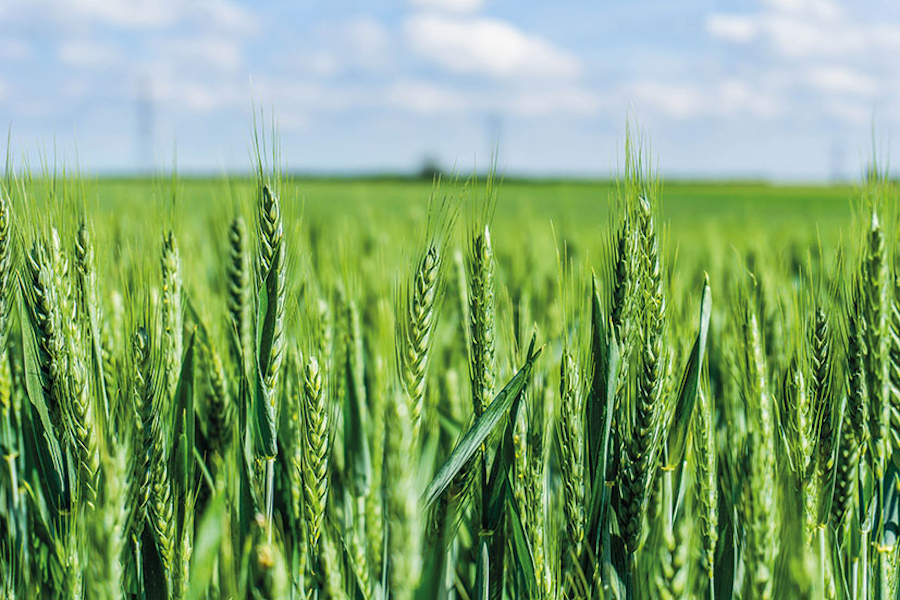Influencing resilient disease control
1st March 2024
Compounding the huge health and growth variation among winter wheat crops this year, recent research by NIAB has shown how leaf layer emergence can vary by 10 days or more within a variety – so accurately timing sprays will not be simple. Speakers at a recent BASF event gave insights into factors which will influence resilient disease control for the winter wheat crop.

NIAB plant pathologist, Dr Aoife O’Driscoll (pictured), said: “This year, because of the very wet autumn and winter, there is an enormous amount of variability in winter wheat crops even within one variety in a field.
“Crops are likely to be shorter than usual, and traditionally when carrying out leaf dissections we can use the height between the internodes to assess the leaf layer emergence between growth stage 30–32; however, this year, that might not be a very good indicator of what leaf layer is emerging so growers will need to be much more accurate in their apical dissections for greater accuracy in their spray timings.”
Variable leaf layer emergence
NIAB trials in Cambridge and Hampshire in 2022 and 2023 looked at leaf layer emergence, and results showed the biggest drivers of how uniformly leaves emerge across a field are variety choice and thermal time.
Dr O’Driscoll said: “In these trials, some varieties had a protracted leaf layer emergence, taking 10 days for all the flag leaves to emerge, whilst others emerged over 3-4 days.
Both the flag leaf and leaf 2, of more ‘resistant’ varieties tended to take a shorter period of time for their leaf layers to emerge, whereas varieties like RGT Saki or KWS Barrel had leaf layers that emerged over a longer time period.”
BASF business development manager, Jared Bonner (right), commented: “This has implications for the spray programme, as leaf layer emergence not only determines spray timings but also dictates the length of time that leaves are exposed to infection.
“Growers generally have to compromise with their spray timing, trying to make applications when two thirds of the target leaves are fully emerged. Because leaf layer emergence is happening at different times within a variety, potentially the targeted leaf could be missed because it has not yet emerged, or the leaf could be left exposed and unprotected before the trigger timing is reached.
“This year, the varied leaf layer emergence will be compounded by the variable stand, so getting the spray timing right will be exceedingly difficult if not impossible. The most effective fungicide programme this year is going to have to cover all the bases, it will have to be protectant and curative, so a fungicide like Revystar XE (Revysol + Xemium) is ideally placed this season.”
Delaying the septoria epidemic
Revystar XE is well known for reportedly keeping crops greener for longer, and ADAS investigated if it could change the pressure of a septoria epidemic and how the disease moves up the wheat plant. In order to do this, ADAS carried out glasshouse trials, with the aim of discovering if delays in septoria epidemics improved disease control within the leaf and within the canopy.
The glasshouse work applied recommended rate fungicides, and the following day septoria spores were introduced, ensuring the fungicides were working protectantly.
After about three weeks there were visible symptoms on the untreated leaf, Univoq (Inatreq + prothioconazole) delayed visible symptoms by a further 10 days, and Revystar XE by 16 days.

Mr Bonner explained: “If there is a delay in seeing the disease on the leaf, it suggests we are delaying the rate that the septoria epidemic can move up to the next leaf layer on the plant. In effect, this result from ADAS is saying that the Revystar XE application has the potential to delay the septoria epidemic moving onto the next leaf.”
In order to see if Revysol could delay septoria pressure moving up the crop in a field situation ADAS applied a single fungicide application at a variety of timings, including an early T2 and a classic T2 timing.
“Results showed, that as well as its protectant and curative properties, Revystar XE is delaying reinfection onto the next to emerge leaves.
Revysol changes the way in which septoria infects the wheat canopy and slows the level of septoria infection on the following leaf which has still to emerge – bringing benefits to the crop and the grower,” said Mr Bonner.
UK septoria population still sensitive to active
Septoria can be difficult to control because its populations contain huge levels of genetic variability. Each year, the AHDB fund fungicide resistance testing, collecting septoria isolates from across the UK, in order to monitor if and how the population is shifting in terms of its sensitivity to a range of chemistries.
Dr O’Driscoll explained: “Revysol has remained very stable over the last four years – our UK septoria population remains sensitive to it. There have been slight shifts in sensitivity to prothioconazole.”
The main form of resistance which affects the azoles is target site resistance with specific mutations occurring over time and certain site-specific mutations accumulating, changing and adapting depending on the azole that is used.
Mr Bonner added: “Revysol’s unique structural flexibility allows it to bond 100 times stronger to the target site on septoria than conventional azoles, and to adapt to changes at the target site caused by mutations, keeping the septoria populations sensitive to Revysol. Revysol continues to give resilient control and is an important azole active ingredient for resistance management when building winter wheat programmes.”
Building resilient disease control programmes
Effective disease control is not only about maintaining healthy canopies and building high quality yield – the products chosen must also integrate within a strategy that maintains the effective long life of the actives available.
“Resistance development associated with the use of fungicides is a well-known risk. In order to achieve effective resistance management, it is important for growers to think about the products that are in their programmes – the modes of action and how the actives are working must be considered. Without that understanding, it is not possible to protect and steward chemistry in order to maintain the long-term efficacy of products.
“When growers mix to protect products, it is worth noting that a product can only protect other actives to the level of control it can itself achieve. Revysol has the best balance of high activity and tolerance to resistance development, making it an ideal product to include in a programme with higher resistance risk modes of action,” said Mr Bonner.


